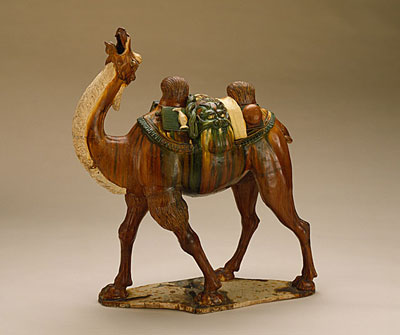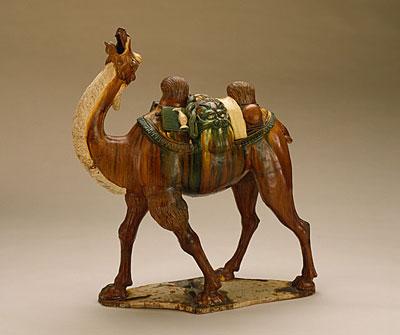Even though LACMA's Chinese galleries have yet to be reinstalled, last month more than 150 students explored one of the department's objects—Funerary Sculpture of a Bactrian Camel—through our distance learning program, which provides real-time, interactive videoconferences to kindergarten through twelfth-grade classrooms nationwide on topics drawn from various areas of the museum's collection. Subsequently, I too found myself drawn to this popular mingqi (clay replicas of a person, animal, or other object that were made to go in the tomb of the deceased).

Funerary Sculpture of a Bactrian Camel, middle Tang dynasty, c. 700-800, William Randolph Hearst Collection
The camel was an import into China from the ancient kingdom of Bactria in present-day Afghanistan, a result of trade on the Silk Road. Able to store fat in two humps, thus needing less drinking water for long periods of time, the camel was the "fuel-efficient" mode of transport for its day. Changes in the camel's behavior, possibly seen in the way the Bactrian Camel has its head thrown back and mouth wide open, were indicative of approaching sandstorms. These camels—strong and gentle—were invaluable for trading goods, some of which we can see packed on the back of the Bactrian Camel.
The distance learning students, who were all studying Mandarin, were engaged by the molded and modeled representation with its strong naturalism, lively pose, and fully packed saddle. High school art students from upstate New York creating their own ceramic vessels found inspiration in the colorful green, brown, and yellow color combination. Placed in a tomb, the Bactrian Camel provided the deceased—in this case a person of wealth and status—with luxury travel in the afterlife.
We looked at examples of other mingqi in comparison to the camel, including the very different Funerary Sculpture of a Chimera (Bixie) and the very similar Funerary Sculpture of a Horse. But the camel, with all its fine detail, won the day. In the context of my virtual and sometimes surreal experience of videoconferencing, it quietly calls out for me its own contemporary narrative about cultural exchange and globalization.
Toni Guglielmo, Education Coordinator, Distance Learning



